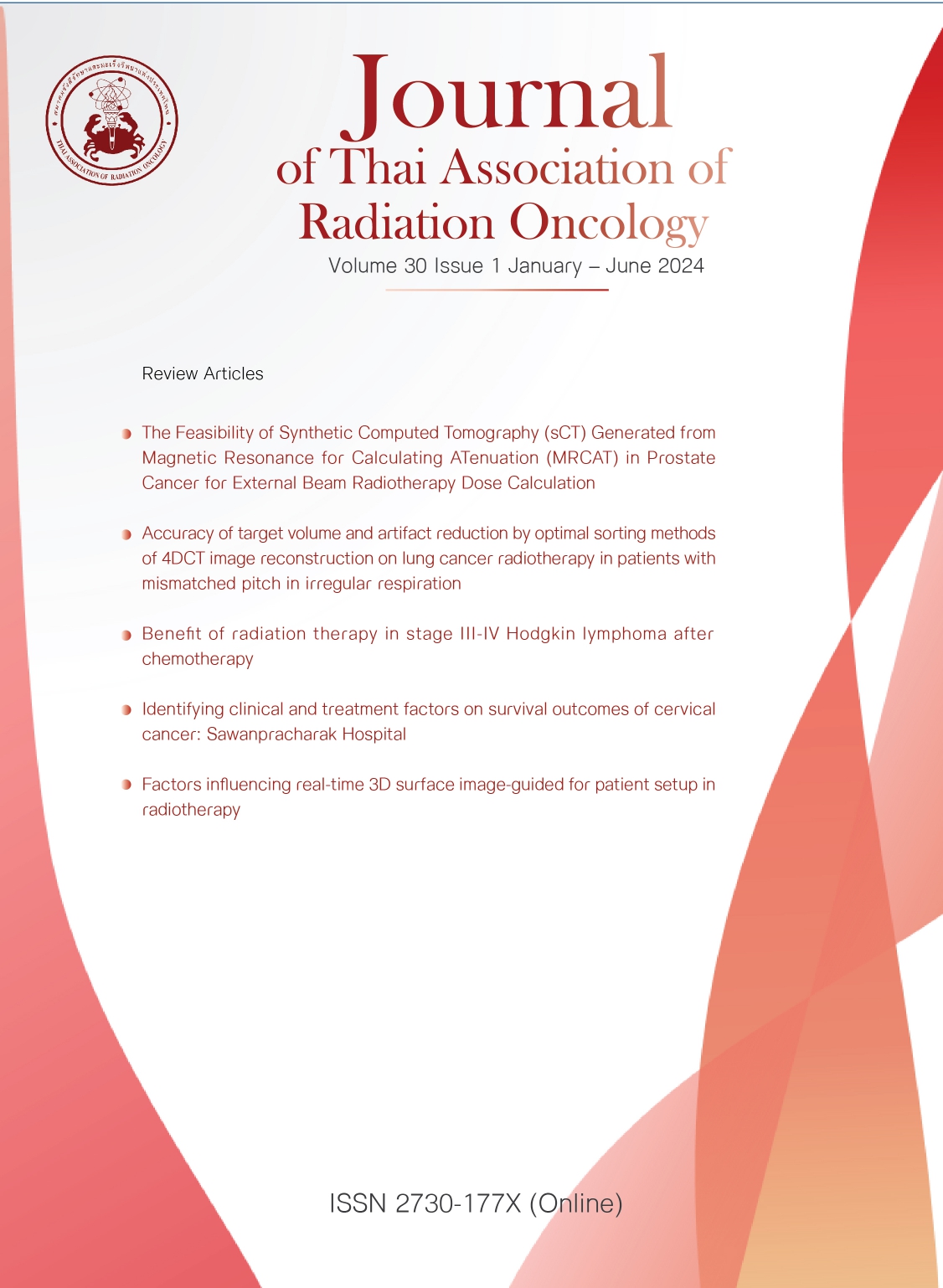Factors influencing real-time 3D surface image-guided for patient setup in radiotherapy
Keywords:
Real-time 3D surface tracking, Real-time 3D surface tracking, non-ionizing radiation, IGRTAbstract
Background: The real-time 3D surface image-guide system (AlignRT) is applied to verify the patient position before treatment and can monitor the patient movement during treatment.
Objective: To study the characteristics and contributing factors of AlignRT.
Materials and Methods: The AlignRT system was installed at Varian TrueBeam linac room. The position errors of phantom were used to study in various parameters such as the effect of gantry angle, room light, skin tone protocol, region of interest, couch angle and time.
Results: From the study, it was found that the gantry angle effect was within 0.3 mm for the range of 100-260 degree. The uncertainty increased in case of dim light in the room with maximum of 0.9 mm. For skin tone protocol, the uncertainty reduced if the matching skin tone was selected. A smaller ROI than 10 x10 cm2, small at center, displayed less errors compared with large ROI such as total body, half left or half right. For couch angle effect, the uncertainties were high in the range -40 to 60 degrees and 40 to 60 degrees with the uncertainty range from -1.3 to 1.1 mm. The time of using machine did not affect the accuracy of the system.
Conclusions: The characteristics of AlignRT system were in good condition with small uncertainty. The highest uncertainty was found at couch angle effect, while the gantry angle and time of used had the smallest effect. The other parameters showed small effect. In conclusion, the
AlignRT was a good system because the uncertainties were within 1.5 mm from all factors. It was possible to increase the accuracy of patient positioning.
References
Laaksomaa M, Kapanen M, Skyttä T, Peltola S, Hyödynmaa S, et al. Estimation of optimal matching position for orthogonal kV setup images and minimal setup margins in radiotherapy of whole breast and lymph node areas. Rep Pract Oncol Radiother 2014;19:369–75.
Laaksomaa M, Kapanen M, Haltamo M, Skytta T, Peltola S, et al. Determination of the optimal matching position for setup images and minimal setup margins in adjuvant radiotherapy of breast and lymph nodes treated in voluntary deep inhalation breath‐hold. Radiat Oncol 2015;10:76.
Wikstrom K, Isacsson U, Nilsson K, Ahnesjo A. Reproducibility of heart and thoracic wall position in repeated deep inspiration breath holds for radiotherapy of left-sided breast cancer patients. Acta Oncol 2018;57:1318–24.
Skyttä T, Kapanen M, Laaksomaa M, Peltola S, Haltamo M, et al. Improving the reproducibility of voluntary deep inspiration breath hold technique during adjuvant left‐sided breast cancer radiotherapy. Acta Oncol 2016;55:970–5.
Li G, Ballangrud A, Chan M, Ma R, Beal K, et al. Clinical experience with two frameless stereotactic radiosurgery (fSRS) systems using optical surface imaging for motion monitoring. J Appl Clin Med Phys 2015;16:149-62.
Willoughby T, Lehmann J, Bencomo JA, Jani SK, Sanranam L, et al. Quality assurance for nonradiographic radiotherapy localization and positioning systems: report of Task Group 147. Med Phys 2012;39:1728–47.
Gierga DP, Riboldi M, Turcotte JC, Sharp GC, Jiang SB, et al. Comparison of target registration errors for multiple image‐guided techniques in accelerated partial breast irradiation. Int J Radiat Oncol Biol Phys 2008;70:1239–46.
Bert C, Metheany KG, Doppke K, Chen GT. A phantom evaluation of a stereo‐vision surface imaging system for radiotherapy patient setup. Med Phys 2005;32:2753–62.
สาขารังสีรักษาและมะเร็งวิทยา คณะแพทยศาสตร์ จุฬาลงกรณ์มหาวิทยาลัย จาก http://www.chulacancer.net/.
Peng JL, Kahler D,Li JG, Samant S, Yan G, Amdur R, et al. Characterization of a real-time surface image -guided stereotactic positioning system. Med Phys 2010;37:5421-33.
Downloads
Published
How to Cite
Issue
Section
License
Copyright (c) 2024 Thai Association of Radiation Oncology

This work is licensed under a Creative Commons Attribution-NonCommercial-NoDerivatives 4.0 International License.
บทความที่ได้รับการตีพิมพ์เป็นลิขสิทธิ์ของวารสารมะเร็งวิวัฒน์ ข้อความที่ปรากฏในบทความแต่ละเรื่องในวารสารวิชาการเล่มนี้เป็นความคิดเห็นส่วนตัวของผู้เขียนแต่ละท่านไม่เกี่ยวข้องกับ และบุคคลากรท่านอื่น ๆ ใน สมาคมฯ แต่อย่างใด ความรับผิดชอบองค์ประกอบทั้งหมดของบทความแต่ละเรื่องเป็นของผู้เขียนแต่ละท่าน หากมีความผิดพลาดใดๆ ผู้เขียนแต่ละท่านจะรับผิดชอบบทความของตนเองแต่ผู้เดียว




